
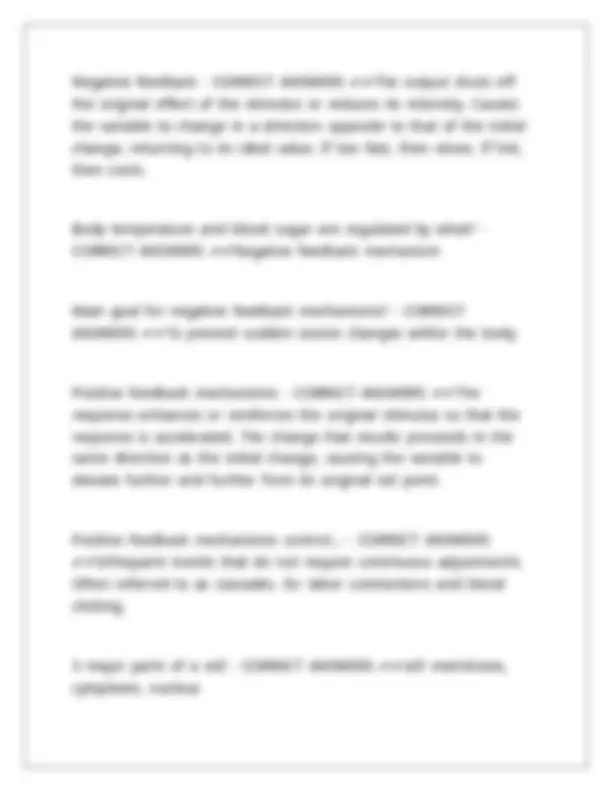
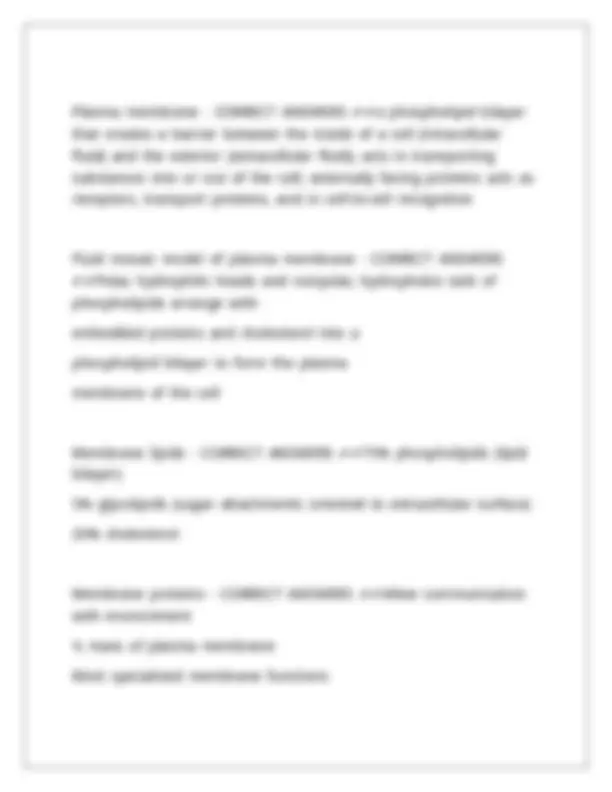
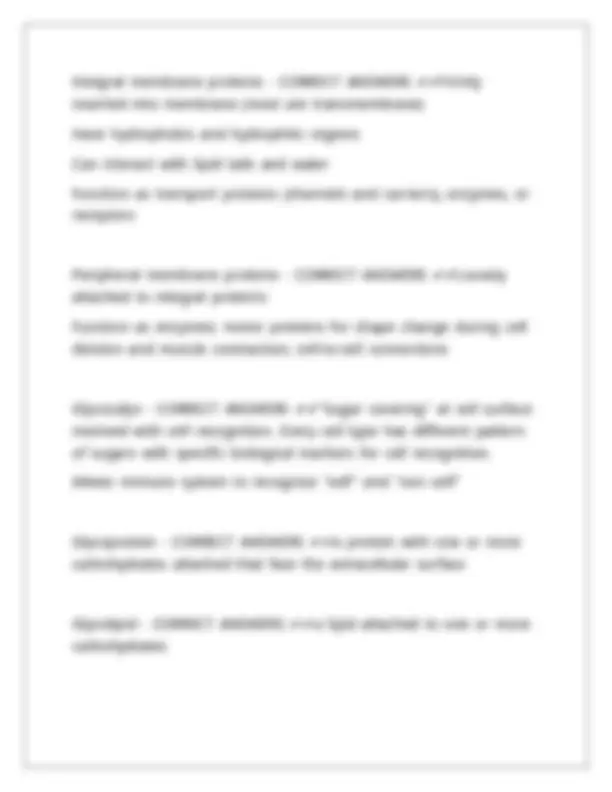
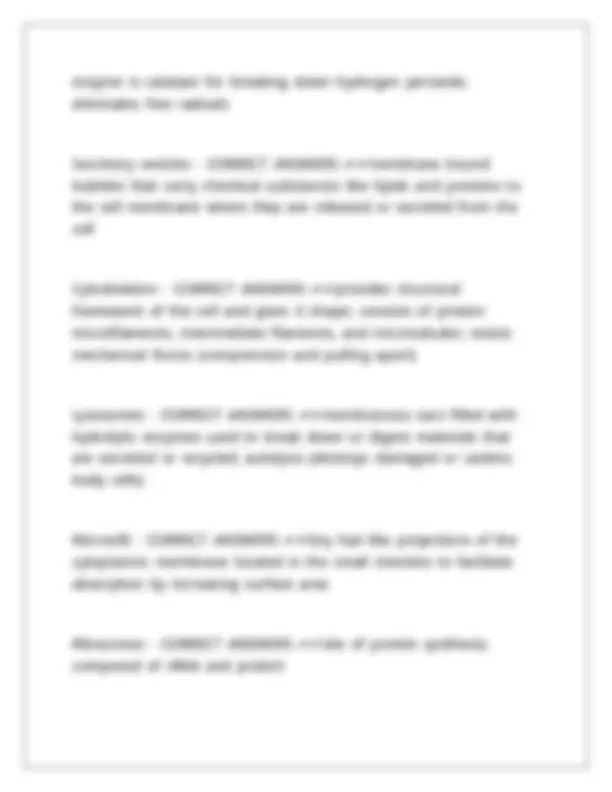
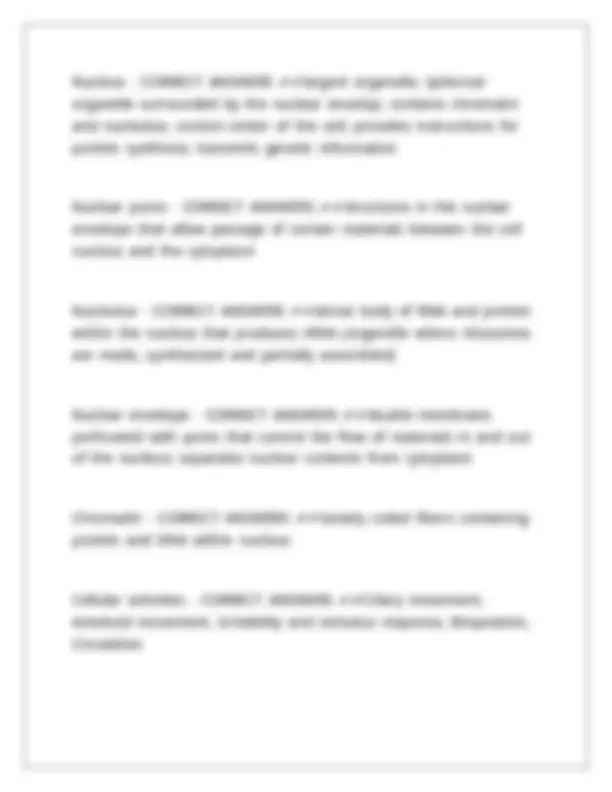
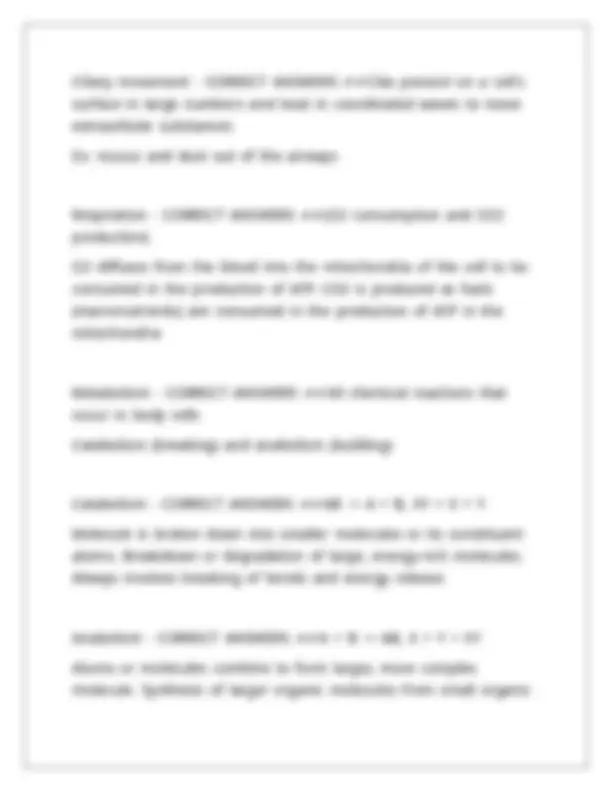


Study with the several resources on Docsity

Earn points by helping other students or get them with a premium plan


Prepare for your exams
Study with the several resources on Docsity

Earn points to download
Earn points by helping other students or get them with a premium plan
Community
Ask the community for help and clear up your study doubts
Discover the best universities in your country according to Docsity users
Free resources
Download our free guides on studying techniques, anxiety management strategies, and thesis advice from Docsity tutors
APHY 201 Module 01 Chapter 1 and 3 Ivy Tech questions with ANSWERS
Typology: Exams
1 / 11

This page cannot be seen from the preview
Don't miss anything!







Anatomy |- |CORRECT |ANSWERS |✔✔Studies |the |structure |of |body | parts |and |their |relationships |to |one |another. Physiology |(modern |definition) |- |CORRECT |ANSWERS |✔✔Studies |the | function |of |the |body, |in |other |words, |how |the |body |parts |work | and |carry |out |their |life |sustaining |activities. |Often |focuses |on | cellular |and |molecular |level. Physiology |(literal |definition) |- |CORRECT |ANSWERS |✔✔Study |of | nature Homeostasis |- |CORRECT |ANSWERS |✔✔Maintenance |of |relatively | stable |internal |environment |due |to |process |bringing |system |back | to |baseline. |Aka |dynamic |state |of |equilibrium |or |balance. What |is |essential |to |maintain |homeostasis? |- |CORRECT |ANSWERS | ✔✔Communication |within |the |body |to |monitor |and |regulate. |All | three |components |(receptor, |control |center, |and |effector) |must |be | functional |to |maintain |homeostasis.
Variable |- |CORRECT |ANSWERS |✔✔Homeostasis |control |mechanism | being |regulated. |Ex: |body |temperature, |heart |rate, |blood |pressure, | oxygen |content |of |blood, |blood |sugar, |etc. Receptor |- |CORRECT |ANSWERS |✔✔First |component: |some |type |of | sensor |that |monitors |the |environment |and |responds |to |changes | called |stimuli, |by |sending |information |(input) |to |the |control |center. Control |center |- |CORRECT |ANSWERS |✔✔Second |component: | receives |information |(input) |from |the |receptor |along |the |afferent | pathway. |Determines |the |set |point, |which |is |the |level |or |range |at | which |a |variable |is |to |be |maintained. Effector |- |CORRECT |ANSWERS |✔✔Third |component: |receives | information |(output) |from |the |control |center |along |the |efferent | pathway. |Provides |the |means |for |the |control |centers |response | (output) |to |the |stimulus. Afferent |- |CORRECT |ANSWERS |✔✔Approaches |the |control |center | (monitors) Efferent |- |CORRECT |ANSWERS |✔✔Exits |the |control |center |(issues | orders |to |muscles |or |glands)
Plasma |membrane |- |CORRECT |ANSWERS |✔✔a |phospholipid |bilayer | that |creates |a |barrier |between |the |inside |of |a |cell |(intracellular | fluid) |and |the |exterior |(extracellular |fluid); |acts |in |transporting | substances |into |or |out |of |the |cell; |externally |facing |proteins |acts |as | receptors, |transport |proteins, |and |in |cell-to-cell |recognition Fluid |mosaic |model |of |plasma |membrane |- |CORRECT |ANSWERS | ✔✔Polar, |hydrophilic |heads |and |nonpolar, |hydrophobic |tails |of | phospholipids |arrange |with | embedded |proteins |and |cholesterol |into |a | phospholipid |bilayer |to |form |the |plasma membrane |of |the |cell Membrane |lipids |- |CORRECT |ANSWERS |✔✔75% |phospholipids |(lipid | bilayer) 5% |glycolipids |(sugar |attachments |oriented |to |extracellular |surface) 20% |cholesterol Membrane |proteins |- |CORRECT |ANSWERS |✔✔Allow |communication | with |environment ½ |mass |of |plasma |membrane | Most |specialized |membrane |functions
Integral |membrane |proteins |- |CORRECT |ANSWERS |✔✔Firmly | inserted |into |membrane |(most |are |transmembrane) Have |hydrophobic |and |hydrophilic |regions Can |interact |with |lipid |tails |and |water Function |as |transport |proteins |(channels |and |carriers), |enzymes, |or | receptors Peripheral |membrane |proteins |- |CORRECT |ANSWERS |✔✔Loosely | attached |to |integral |proteins | Function |as |enzymes; |motor |proteins |for |shape |change |during |cell | division |and |muscle |contraction; |cell-to-cell |connections Glycocalyx |- |CORRECT |ANSWERS |✔✔"Sugar |covering" |at |cell |surface | involved |with |cell |recognition. |Every |cell |type |has |different |pattern | of |sugars |with |specific |biological |markers |for |cell |recognition. Allows |immune |system |to |recognize |"self" |and |"non |self" Glycoprotein |- |CORRECT |ANSWERS |✔✔a |protein |with |one |or |more | carbohydrates |attached |that |face |the |extracellular |surface Glycolipid |- |CORRECT |ANSWERS |✔✔a |lipid |attached |to |one |or |more | carbohydrates
respiration); |double-membrane |structure; |contains |own |DNA |and | ribosomes Rough |endoplasmic |reticulum |- |CORRECT |ANSWERS |✔✔system |of | membranes |that |appear |rough |due |to |the |presence |of |ribosomes | which |manufacture |all |proteins |secreted |from |cells; |functions |to | manufacture |all |secreted |proteins |and |membrane |integral |proteins | and |phospholipids, |and |attach |sugar |groups |to |proteins |in |the | cisterns. |Proteins |are |bound |to |vesicles |for |transport |to |the |Golgi | apparatus |and |other |sites. Smooth |endoplasmic |reticulum |- |CORRECT |ANSWERS |✔✔network |of | interconnected |membranes |forming |channels |within |the |cell |that | are |free |of |ribosomes; |contains |enzymes |that |function |to |produce | transport |vesicles, |synthesize |of |lipids |and |steroids, |detoxify | substances, |regulate |cellular |calcium |levels Golgi |apparatus |- |CORRECT |ANSWERS |✔✔Stack |of |flattened | membranes |in |the |cell |that |modifies, |sorts, |and |packages |proteins | and |lipids |created |in |the |endoplasmic |reticulum; |segregates | proteins |for |secretion |from |the |cell, |inclusion |in |lysosomes, |and | incorporation |into |the |plasma |membrane Peroxisomes |- |CORRECT |ANSWERS |✔✔membranous |sacs |of | catalase |and |oxidase |enzymes; |detoxify |substances; |most |important |
enzyme |is |catalase |for |breaking |down |hydrogen |peroxide; | eliminates |free |radicals Secretory |vesicles |- |CORRECT |ANSWERS |✔✔membrane |bound | bubbles |that |carry |chemical |substances |like |lipids |and |proteins |to | the |cell |membrane |where |they |are |released |or |secreted |from |the | cell Cytoskeleton |- |CORRECT |ANSWERS |✔✔provides |structural | framework |of |the |cell |and |gives |it |shape; |consists |of |protein | microfilaments, |intermediate |filaments, |and |microtubules; |resists | mechanical |forces |(compression |and |pulling |apart) Lysosomes |- |CORRECT |ANSWERS |✔✔membranous |sacs |filled |with | hydrolytic |enzymes |used |to |break |down |or |digest |materials |that | are |excreted |or |recycled; |autolysis |(destroys |damaged |or |useless | body |cells) Microvilli |- |CORRECT |ANSWERS |✔✔tiny |hair-like |projections |of |the | cytoplasmic |membrane |located |in |the |small |intestine |to |facilitate | absorption |by |increasing |surface |area Ribosomes |- |CORRECT |ANSWERS |✔✔site |of |protein |synthesis; | composed |of |rRNA |and |protein
Ciliary |movement |- |CORRECT |ANSWERS |✔✔Cilia |present |on |a |cell's | surface |in |large |numbers |and |beat |in |coordinated |waves |to |move | extracellular |substances | Ex: |mucus |and |dust |out |of |the |airways Respiration |- |CORRECT |ANSWERS |✔✔(O2 |consumption |and |CO2 | production) O2 |diffuses |from |the |blood |into |the |mitochondria |of |the |cell |to |be | consumed |in |the |production |of |ATP. |CO2 |is |produced |as |fuels | (macronutrients) |are |consumed |in |the |production |of |ATP |in |the | mitochondria Metabolism |- |CORRECT |ANSWERS |✔✔All |chemical |reactions |that | occur |in |body |cells Catabolism |(breaking) |and |anabolism |(building) Catabolism |- |CORRECT |ANSWERS |✔✔AB |-> |A |+ |B, |XY |= |X |+ |Y Molecule |is |broken |down |into |smaller |molecules |or |its |constituent | atoms. |Breakdown |or |degradation |of |large, |energy-rich |molecules. | Always |involves |breaking |of |bonds |and |energy |release. Anabolism |- |CORRECT |ANSWERS |✔✔A |+ |B |-> |AB, |X |+ |Y |= |XY Atoms |or |molecules |combine |to |form |larger, |more |complex | molecule. |Synthesis |of |larger |organic |molecules |from |small |organic |
molecular |subunits. |Always |involve |bond |formation |and |energy | consumption. Secretion |- |CORRECT |ANSWERS |✔✔a |process |by |which |substances | are |produced |and |discharged |from |a |cell, |gland, |or |organ |for |a | particular |function |in |the |organism. |Golgi |apparatus |regulates | formation |and |release |of |secretory |vesicles. |Ex: |digestive |enzymes, | surfactant, |sebum Excretion |- |CORRECT |ANSWERS |✔✔Removal |of |wastes |from | metabolism |and |digestion Ex: |urea, |carbon |dioxide, |feces Apoptosis |- |CORRECT |ANSWERS |✔✔programmed |cell |death Necrosis |- |CORRECT |ANSWERS |✔✔death |of |living |tissue |due |to | injury |or |disease Hypertrophy |- |CORRECT |ANSWERS |✔✔increase |in |cell |size Hyperplasia |- |CORRECT |ANSWERS |✔✔increase |in |cell |number Atrophy |- |CORRECT |ANSWERS |✔✔decrease |in |cell |size